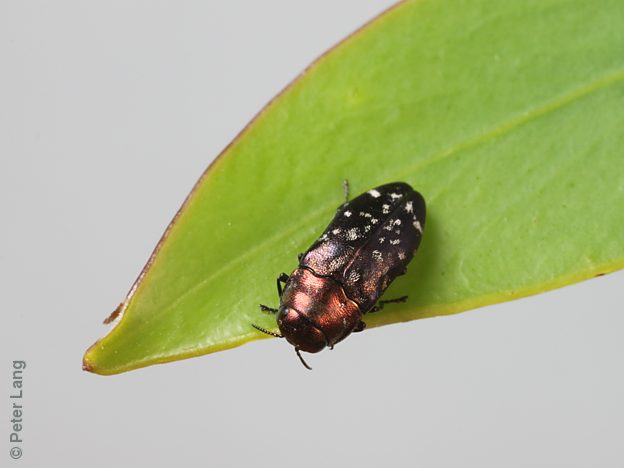
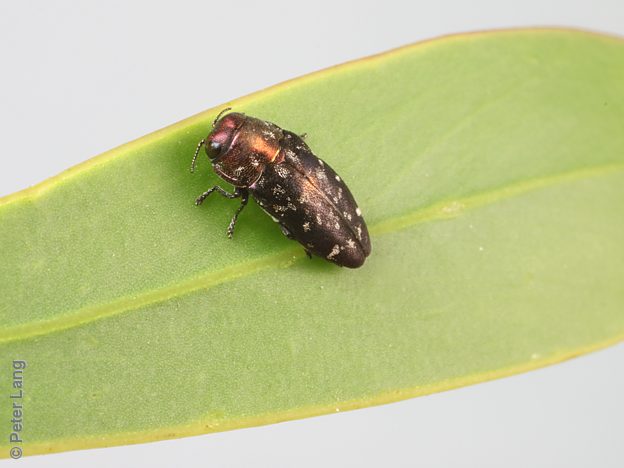
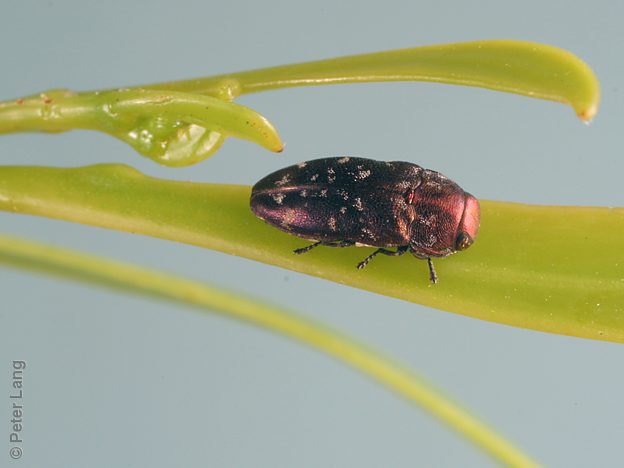
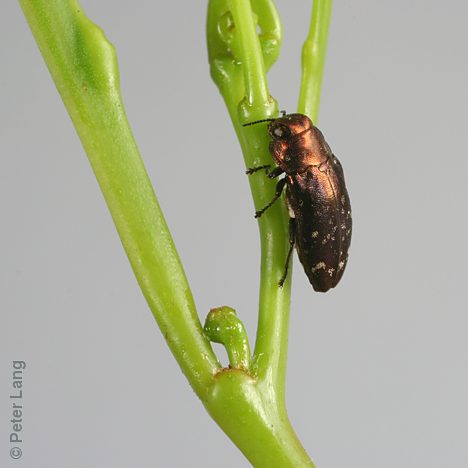
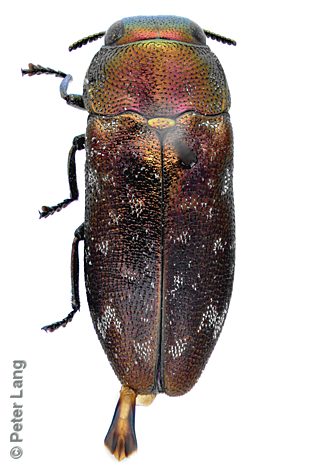
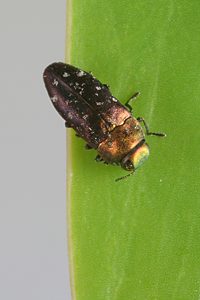
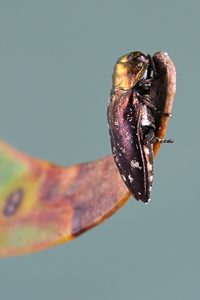
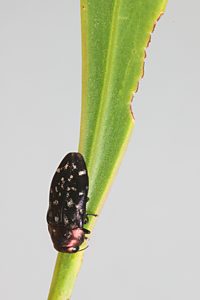
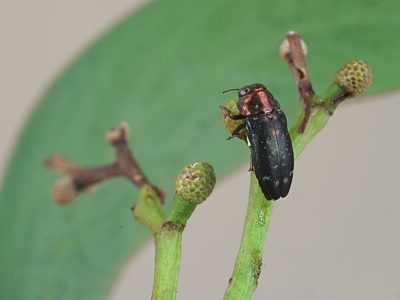
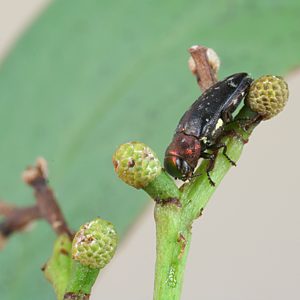
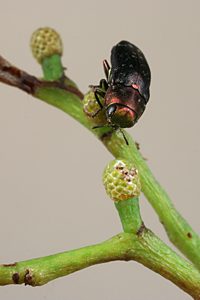
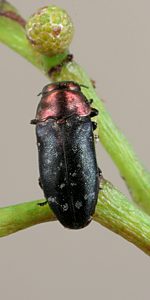
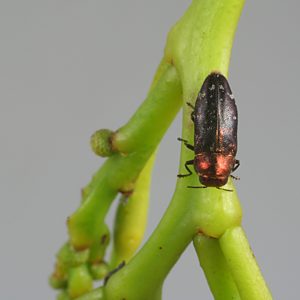
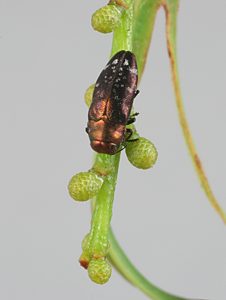
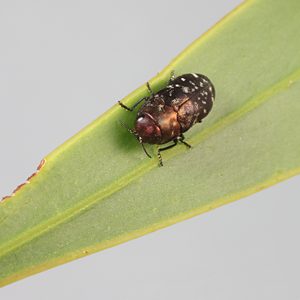
size¹:
×
2.1 mm















| male | female | |||||
|---|---|---|---|---|---|---|
| L1 | 5.2 | 4.6 – 5.8 | n = 41 | 5.4 | 4.05 – 6.2 | n = 27 |
| L2 | 4.9 | 4.55 – 5.7 | n = 10 | 5.3 | 4.75 – 6.1 | n = 7 |
| W | 2.1 | 1.8 – 2.4 | n = 41 | 2.1 | 1.6 – 2.45 | n = 27 |
| Legend | L1 | length from clypeus/frons to elytral apex (mean, range, sample size) |
| L2 | length from anterior of edge of eyes to elytral apex | |
| W | maximum width with elytra fully closed |
Based on Kerremans 1898, D. modesta differs from D. semiobscura in having the elytra purplish black (vs. purple) with traces of grey mottling (vs. light grey speckles), the antennae & tarsi black (vs. 'obscure' [= dark]), and the pronotum and scutellar region a shiny copper purple (vs. purple). Also the head is green (vs. purple), but this may simply be a result of different sexes being described. Structural differences apparent in the accounts of the two species seem slight and inconsequential: dimensions 5 x 1.7 mm (vs. 5 x 1.8 mm); pronotum sides arched (vs. fairly arched); pronotum base with median lobe a little indented (vs. barely indented); elytra with small transverse wrinkles (vs. with rugosities resembling scales).
An extremely common and variable species for which the limits of variation are difficult to define. It is closely related to Diphucrania semiobscura (q.v.) which has an identical aedeagus and may not be separable as a distinct species.
The original description of this species (as Cisseis modesta) by Kerremans 1898 was followed on the same page by an adjacent protologue for C. semiobscura. Kerrremans introduced C. semiobscura stating that it had the appearance of C. modesta but was different in regard to certain details of structure and colouration but did not elaborate further. The differences given under 'Distinctive features' above are derived from a comparison of his brief descriptions for the two species.
Analysis of preliminary DNA barcode sequences (mitochondrial CO-1) divided D. modesta and D. semiobscura samples into two tightly clustered and well separated sister groups: a sample of six individuals from the Mt Lofty Ranges (Belair, Mt Barker, Lobethal and Kapunda areas) and a sample of nine individuals from the Murray Mallee, southern Flinders Ranges and Eyre Peninsula (Monarto, Quorn, Kimba and Edilillie areas). The first group includes some 'typical' D. modesta forms with blackish elytra and coppery pronotum, and the latter some with more purplish elytra and pronotum that fit C. semiobscura. However, forms from the southern Mt Lofty Ranges (including some samples that grouped with typical C. modesta) often have the elytra dark coppery bronze to purplish rather than blackish. There is much variation, and it is not possible to find consistent colour or morphological differences corresponding to the two groups, nor any distinction based on adult host plants. A more detailed study with nuclear DNA may help resolve the taxonomy of this complex.
| Legend | P.J.Lang collection vouchered records | |
| other private collection or museum specimens, or sightings |
|
|
|
|
|
|
|
|
|
|
|
|
|
||||||||||||||||||||||||||||||||||||||||||||||||
|
|
|
|
|
|
|
|
|
|
|
|
|
||||||||||||||||||||||||||||||||||||||||||||||||
| Jul | Aug | Sep | Oct | Nov | Dec | Jan | Feb | Mar | Apr | May | Jun |
| Legend | ||
9 | number of active beetles, actually recorded in that quarter-month | |
| actual count > 18 (median) | ||
| actual count <= 18 (median) | ||
| beetles | sites | SA regions¹ | family | position on host plant | |||
| Acacia pycnantha | 264 | 31 | FR, NL, MU, SL | F | |||
| Acacia sp. | 26 | 7 | EP, SL | F | |||
| Acacia quornensis | 11 | 2 | EP | F | |||
| Acacia retinodes | 6 | 5 | NL, SL | F | |||
| Allocasuarina verticillata | 4 | 1 | SL | C1 | |||
| Acacia wattsiana | 2 | 2 | NL | F | |||
| *Acacia pycnantha | 1 | 1 | NL | F | |||
| Allocasuarina muelleriana ssp. muelleriana | 1 | 1 | SL | C1 | |||
| Callitris gracilis | 1 | 1 | MU | C2 | |||
| Calytrix tetragona | 1 | 1 | FR | M | |||
| Leptospermum myrsinoides | 1 | 1 | SL | M | |||
| Leptospermum sp. | 1 | 1 | MU | M |
| Legend | beetles | count of beetles collected from, or sighted on, host plant taxon |
| sites | count of major sites (unique 10 km grid cells +/- some distinct approximate localities) | |
| * | indicates alien (non-native) plant occurrences, either wild or planted (the species may be alien in SA, or native in parts of its SA range) | |
| Plant names in green are hyperlinked to a matching host species page with plant photos. | ||
| Code | beetles | % | host plant taxa | |
| F | Fabaceae | 310 | 97% | 4 |
| C1 | Casuarinaceae | 5 | 2% | 2 |
| M | Myrtaceae | 3 | 1% | 2 |
| C2 | Cupressaceae | 1 | 0% | 1 |
| position | beetles | sites | |
| on flower(s) | 5 | 1 | |
| on flowering plant | 1 | 1 | |
| on foliage or non-flowering plant | 236 | 30 | |
| on plant (unspecified) | 77 | 16 |
| ¹ Legend | regions | SA State Herbarium regions (map) EA: Eastern, EP: Eyre Peninsula, FR: Flinders Ranges, GT: Gairdner-Torrens, KI: Kangaroo Island, LE: Lake Eyre, MU: Murray, NL: Northern Lofty, NU: Nullarbor, NW: North-Western, SE: South-Eastern, SL: Southern Lofty, YP: Yorke Peninsula |
| size | The ellipse is the correct size when printed, indicative on a desktop screen, and likely to be wrong on a mobile device. |